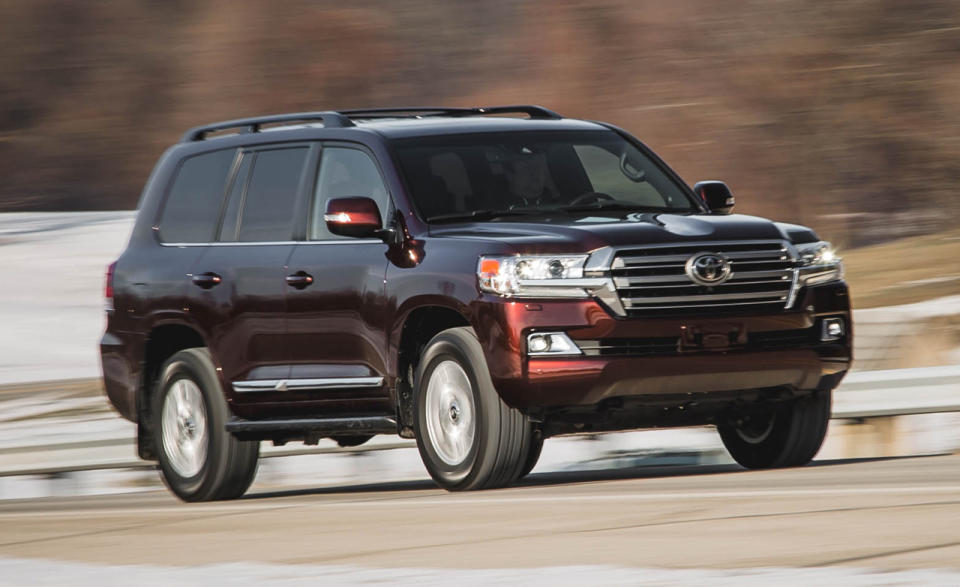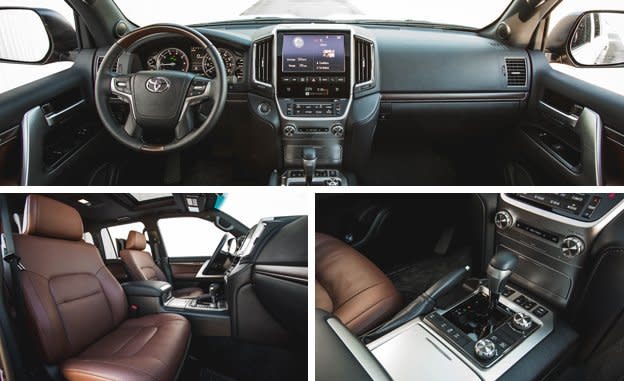2016 Toyota Land Cruiser

Some long-running automotive nameplates are constantly updated in an attempt to remain relevant. Not the Toyota Land Cruiser. The Land Cruiser scoffs at change.
Aside from ditching its old-school solid front axle and venerated inline six-cylinder back in 1998, the Cruiser’s updates have largely focused on creature comforts and sheetmetal revisions. When the current iteration (a J200 in Toyota-speak) appeared in 2008 with a 5.7-liter V-8 replacing the previous 4.7-liter V-8, it had been nearly a decade in the making. Toyota performed a mild refresh in 2013, whereupon it took the opportunity to cram it chock-full of nearly every infotainment and electronic safety-nanny feature in the Toyota canon.
For the 2016 model year, Toyota decided to get really crazy and update the Land Cruiser with a revised front fascia, front fenders, and lighting elements, making it look fresh—from the windshield forward, at least. It also swapped out the six-speed automatic for an eight-speed unit and brought the electro-wizardry up to date again. Change may come slowly to the Land Cruiser, but the king of the off-road mountain can’t stand pat while others innovate.
The Crown Rests Heavy
At 5926 pounds as tested, there’s no getting around the Land Cruiser’s heft. But as with a classic revolver or a quality hand tool, every ounce earns its keep. You notice it instantly. The interior door latches, for instance, feel and operate as if they were designed for demanding environments. A high, flat floor to allow ground clearance necessitates a “legs forward” seating position, and while there is elbow and shoulder room to spare, headroom can be a little tight for those much over six feet tall. The beltline is low and your torso high, providing what they referred to in the early days of SUV-mania as a “commanding view.” The second row is spacious enough to seat a trio of corn-fed Midwesterners in relative comfort, but while Toyota says the third-row seats also offer room for three, our experience indicates their use is best reserved for dire predicaments such as having young children who need to go somewhere. That said, we find their distinctive fold-to-the-side functionality a nice nod to the Cruiser’s past, even if they aren’t as space-efficient as some fold-flat third-row setups. All passengers, regardless of seating position, will enjoy the standard leather interior surfaces.

With 381 horsepower and 401 lb-ft of torque on tap from the naturally aspirated 5.7-liter V-8, the Land Cruiser will never be in danger of ending up on a podium at the drag strip. But just because it can’t keep pace with the likes of the 6.2-liter-equipped Cadillac Escalade doesn’t mean it’s pathologically pokey. Employing the well-spaced ratios of the new-for-’16 eight-speed automatic, we managed to hustle it to 60 mph in 6.7 seconds utilizing the time-tested brake-torque technique for the best launch. The quarter-mile fell in 15.1 seconds, the Cruiser clearing the traps at 93 mph. For the record, that’s 0.2 second slower to 60 mph but the same quarter-mile elapsed time (albeit 1 mph slower) as when we tested a six-speed Cruiser back in 2008. All the same, getting to 60 mph in less than seven seconds is impressive for a vehicle initially conceived as a wheeled alternative to the pack mule.
Speaking of pack mules, the Land Cruiser still relies on its time-proven, full-time four-wheel-drive system, with driver input limited to the choice of either high- or low-range selections via a console-mounted dial. The limited-slip center differential is a Torsen unit that runs a default 40/60 front-to-rear torque split but can send more grunt fore or aft as needed. Toyota’s Active Traction Control (A-TRAC) employs both brake and throttle intervention to help control wheelspin, while a collection of driver-selected settings (Multi-Terrain, Mogul, Crawl, Downhill Assist, and Hill-Start Assist) can optimize the drivetrain for different types of tough terrain. We found a muddy riverfront area to play in but couldn’t find a hole messy enough to stop the Land Cruiser, let alone necessitate the use of low range. Later, we barreled through a typical Michigan freak spring snow/hailstorm at highway speeds in quiet, secure comfort. For our final act of derring-do, we darted down an abandoned railroad siding, which, based on our relatively low contusion count, underscored the finer points of an independent front suspension and tall-ish tire sidewalls when negotiating rough surfaces.
Flogging and Cruising
While flogging the Cruiser may yield minor off-road giggles, the experience from the helm rarely approaches anything that could be considered edgy. Every motion is deliberate, and, as you’d expect of an abuse-swilling vehicle bordering on three tons, the steering feels heavy. Reasonably direct and with a nice on-center valley, it nonetheless acts as if the steering fluid has been replaced with cough syrup. Just for laughs—no, we weren’t sampling the cough syrup—we wheeled the Cruiser onto our 300-foot cornering-test circle, where its weight, tires, and undefeatable stability control conspired to limit grip to 0.74 g. Stomping hard on the brake pedal produced 184-foot stops from 70 mph, and repeated attempts revealed no fade. Capable of towing 8100 pounds, the Land Cruiser also features Trailer Sway Control, which uses the stability-control system to cancel those unnerving side-to-side oscillations while pulling a load.

Surprisingly, the big guy returned 14 mpg in our hands, nearly matching its 15-mpg EPA combined number. EPA city and highway estimates are 13 and 18 mpg, respectively.
Toyota is proud of its well-equipped Land Cruiser and—in a refreshing twist—doesn’t leave many options on the table. Standard kit includes the upgraded-for-2016 Entune head unit with 14-speaker JBL Synthesis audio, a 9.0-inch touchscreen with Siri Eyes Free voice-recognition tech, and 11.6-inch screens for the rear passengers. The Qi wireless inductive charging pad will please phone junkies who use the feature. The standard Safety Sense P system added this year includes a pre-collision warning, pedestrian detection, and automatic emergency braking. Lane-departure warning, automatic high-beams, and radar-based active cruise control also aid the driver in negotiating the perils of automotive travel. In a sign that this new technology has been added onto an older vehicle, however, the adaptive cruise annoyingly doesn’t operate all the way down to a stop. Still, we appreciate Toyota giving the driver the option to switch between active (with automatic braking to maintain the gap with the vehicle ahead) and standard cruise control.
With options essentially limited to paint, floor mats, remote start, and a few other inconsequential items, one must work hard to add more than $2200 to the sticker. Our test example had only a cargo net ($49), a pair of wireless headphones ($80), and a set of all-weather floor mats ($250), adding $379 to its $84,820 base MSRP. (Buyers interested in spending more money, and some quality time with an order sheet, are advised to check out the Land Cruiser’s even more lavishly equipped cousin, the Lexus LX570).
Despite Toyota’s attempts to drag it into the 21st century, the Land Cruiser feels very much the product of an era when form followed function, cost be damned. The function in this case is the triple-pronged tenet of old-school SUV superiority: durability, reliability, and capability. The swank interior and layers of technology are just nice bonuses.
Specifications >
VEHICLE TYPE: front-engine, 4-wheel-drive, 8-passenger, 4-door hatchback
PRICE AS TESTED: $85,199 (base price $84,820)
ENGINE TYPE: DOHC 32-valve V-8, aluminum block and heads, port fuel injection
Displacement: 346 cu in, 5663 cc
Power: 381 hp @ 5600 rpm
Torque: 401 lb-ft @ 3600 rpm
TRANSMISSION: 8-speed automatic with manual shifting mode
DIMENSIONS:
Wheelbase: 112.2 in
Length: 194.9 in
Width: 77.9 in Height: 74.0 in
Passenger volume: 141 cu ft
Cargo volume: 16 cu ft
Curb weight: 5926 lb
C/D TEST RESULTS:
Zero to 60 mph: 6.7 sec
Zero to 100 mph: 17.6 sec
Zero to 120 mph: 28.6 secRolling start, 5–60 mph: 7.1 sec
Top gear, 30–50 mph: 3.9 sec
Top gear, 50–70 mph: 5.1 sec
Standing ¼-mile: 15.1 sec @ 93 mph
Top speed (C/D est): 130 mph
Braking, 70–0 mph: 184 ft
Roadholding, 300-ft-dia skidpad*: 0.74 g
FUEL ECONOMY:
EPA city/highway driving: 13/18 mpg
C/D observed: 14 mpg
*Stability-control-inhibited

 Yahoo Autos
Yahoo Autos 